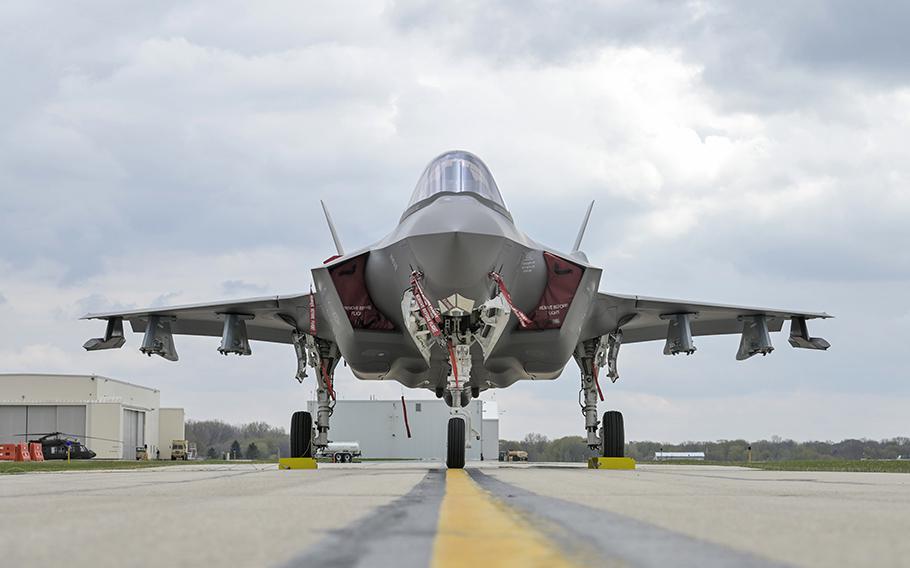
One of the first three F-35A Lightning II aircraft assigned to the Wisconsin Air National Guard’s 115th Fighter Wing arrives at Dane County Regional Airport in Madison, Wisconsin, Apr. 25, 2023. (Mary Greenwood/U.S. Air Force)
(Tribune News Service) — Hawthorne Elementary School teacher Melina Lozano doesn't need data to know the F-35 jets at Truax Field are a lot louder than the F-16s they replaced.
When an F-35 recently flew above a group of first-graders outside the school, located just south of the airfield, she said they started screaming and covering their ears.
One first-grader observed, "'Those planes are twice as loud as the old planes," Lozano said.
With F-35 jets at Truax now a firm reality — the first of 20 arrived in April — those who fought the decision to station the jets with the Wisconsin Air National Guard's 115th Fighter Wing have turned their attention to measuring and monitoring how much noise the jets are really making.
But the military and activists don't even agree on numbers.
Safe Skies Clean Water Wisconsin, which fought vociferously against the military's decision to move F-35s to Madison, has installed noise monitors near Truax.
The Federal Aviation Administration considers 65 decibels to be "incompatible" with residential use, though not uninhabitable.
Children are especially susceptible to the health impacts of exposure to loud noise, which includes problems with cognitive development. Overall, health impacts from prolonged exposure to noise can harm the cardiovascular system, according to the World Health Organization.
On June 1, Safe Skies had a reading of 116 decibels from a jet overhead at the intersection of North Fair Oaks and Home avenues, just south of East Washington Avenue.
The F-16s typically had peak decibel readings in the low 100s, said Steve Klafka, an environmental engineer and member of Safe Skies Clean Water.
"I think the physical observation is they're definitely louder but also it's a bigger sound," Klafka said. "It's definitely more obnoxious."
Aviation and military authorities, though, assert that such monitoring is not a practical way to measure noise over a large area because sounds that come from things other than planes can influence the reading, among other considerations. Instead, airports such as the Dane County Regional Airport use noise modeling to determine the average noise a wide swath of land gets exposed to over time.
Klafka counters, however, that because that modeling relies on averages, it doesn't factor in peak noise a person might experience in the moment.
An Air Force environmental impact found that the presence of the F-35s will increase takeoffs from Truax by 27% and expose more than 1,000 homes to average daily noise of 65 decibels or more.
Study ongoing
The airport is completing a Noise Compatibility Program, which will conclude what the airport can do for land that's impacted by noise.
On June 27, the public may give feedback on the airport's noise study. An open house will be held in the airport lobby between Terminal Doors 1 and 2 between 5:30 and 7:30 p.m.
Scientific disagreements aside, Madison remains years away from retrofitting homes and apartment buildings for noise mitigation as federal and state agencies slog through grants, feasibility studies and community outreach to take advantage of the limited federal funding available for it.
A recent $798,000 federal grant to the state Department of Military Affairs will fund a study so the state can explore potential options for noise abatement. From there, the department will make recommendations to the U.S. Department of Defense to get funding for noise abatement, which will be awarded in winter 2024, according to the defense department.
But of the $75 million available through the Pentagon, only $5 million can go toward the few communities like Madison and Burlington, Vermont, that have transitioned to a new kind of aircraft such as the F-35 since 2019.
The majority of the funding will go to active military and reserve installations.
The question of noise mitigation could complicate future residential developments in the area around the airport. The city is moving forward on the redevelopment of Raemisch Farm to the west of the airport. The $150 million development would include market-rate housing, commercial space, parks and agricultural space. The farm sits between North Sherman and Packers avenues.
Another developer is proposing a 192-apartment complex at 3100 E. Washington Ave. to the airport's south.
Ald. Amani Latimer Burris, 12th District, represents much of the area around the airport.
"I think we're a long way off from firm solutions. That's OK," she said, adding that she's unsure whether the city could require developers to include noise mitigation in their proposals.
"The question is what is to be done about it and who's going to pay for it," she said.
(c)2023 The Wisconsin State Journal (Madison, Wis.)
Visit The Wisconsin State Journal
Distributed by Tribune Content Agency, LLC.